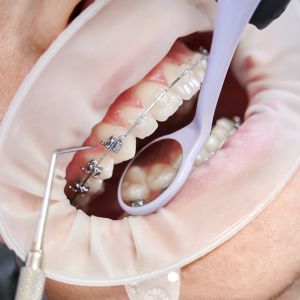How Traditional Metal Braces Work
Orthodontic treatment with metal braces aims to correct issues like crowded teeth, overbites, underbites, and other misalignments. The orthodontist adjusts the arch wires periodically, which apply gentle, continuous pressure on the teeth. This pressure encourages the teeth to move slowly and steadily into their proper position. The duration of treatment varies depending on the severity of the misalignment but typically ranges from one to three years.
Getting Mental braces
Are Traditional Braces Right for You? Pros and Cons:
Traditional metal braces have several advantages that contribute to their popularity. They are proven to be effective for treating a wide range of orthodontic issues, including severe cases of misalignment, crowded teeth, and bite problems. Metal braces are also often the most affordable option for teeth straightening.
On the other hand, metal braces do have some drawbacks to consider. They are the most visible form of braces. Metal braces can also cause initial discomfort and irritation due to the brackets and wires rubbing against the cheeks and lips. Additionally, there are dietary restrictions associated with traditional braces.
How Lingual Braces Work
Lingual braces function similarly to traditional braces, gradually moving the teeth into proper alignment by applying consistent pressure. The primary difference lies in their placement behind the teeth, which keeps them hidden from view. Treatment duration with lingual braces typically ranges from 18 to 36 months, depending on the severity of the misalignment.
Getting Lingual Braces
Are Lingual Braces Right For You? Pros and Cons:
Lingual braces offer several advantages, including their discrete nature, making them virtually invisible when you smile. This can be a significant benefit for those who are self-conscious about their appearance during orthodontic treatment.
However, there are some drawbacks to consider when choosing lingual braces. They can be more expensive than other orthodontic options, and the initial adjustment period may include speech difficulties and tongue discomfort. Additionally, cleaning lingual braces can be more challenging due to their placement behind the teeth.
 Ceramic braces combine the power of traditional metal braces with the added benefit of a subtle appearance, giving people of all ages the opportunity to achieve a confident smile without drawing attention to their orthodontic treatment. Ceramic braces have been steadily gaining popularity in the field of orthodontics, providing an effective and aesthetically pleasing solution for a diverse range of dental issues. Ceramic braces typically cost between $4,000 and $8,000 on average.
Ceramic braces combine the power of traditional metal braces with the added benefit of a subtle appearance, giving people of all ages the opportunity to achieve a confident smile without drawing attention to their orthodontic treatment. Ceramic braces have been steadily gaining popularity in the field of orthodontics, providing an effective and aesthetically pleasing solution for a diverse range of dental issues. Ceramic braces typically cost between $4,000 and $8,000 on average. How Ceramic Braces Work:
Ceramic braces function similarly to traditional metal braces, using consistent pressure to gradually move the teeth into proper alignment. The key difference lies in their aesthetic appeal, with the tooth-colored brackets and ligatures making them less visible. Treatment duration with ceramic braces is generally comparable to that of metal braces, ranging from 18 to 36 months, depending on the severity of the misalignment.
Getting Ceramic Braces
Are Ceramic Braces Right for You? Pros and Cons:
 Clear aligners have revolutionized the world of orthodontics by offering a virtually invisible and removable option for teeth straightening. People of all ages can now achieve a confident, beautiful smile without the need for noticeable brackets and wires. Invisalign treats a variety of misalignment issues and aligns your teeth into a proper position. While they may come with a higher price tag compared to traditional braces, their convenience, comfort, and invisible design make them an attractive choice for many patients seeking teeth straightening without compromising their appearance. Clear aligners can cost anywhere between $3,000 and $8000.
Clear aligners have revolutionized the world of orthodontics by offering a virtually invisible and removable option for teeth straightening. People of all ages can now achieve a confident, beautiful smile without the need for noticeable brackets and wires. Invisalign treats a variety of misalignment issues and aligns your teeth into a proper position. While they may come with a higher price tag compared to traditional braces, their convenience, comfort, and invisible design make them an attractive choice for many patients seeking teeth straightening without compromising their appearance. Clear aligners can cost anywhere between $3,000 and $8000.
How Clear Aligners Work
Clear aligners work by applying consistent pressure to the teeth, guiding them into proper alignment over time. Patients receive a new set of aligners every one to two weeks, with each set designed to make incremental adjustments to the teeth’s position. Treatment duration with clear aligners typically ranges from 6 to 24 months, depending on the severity of the misalignment and the patient’s compliance with wearing the aligners as prescribed.
Getting Clear Aligners
Are Clear Aligners Right for You? Pros and Cons:
Clear aligners offer several advantages, including their virtually invisible design, making them a discrete choice for teeth straightening. They are also removable, allowing patients to eat, drink, brush, and floss with ease.
However, there are some drawbacks to consider as they can be more expensive than other orthodontic options and may not be suitable for severe cases of misalignment or complex orthodontic issues.
Getting Retainers
Are Retainers Right for You? Pros and Cons:
Retainers are essential for preserving the results of teeth straightening treatments. They are usually lightweight, comfortable, and can be easily cleaned. However, removable retainers require patient compliance and can be lost or damaged if not cared for properly.
How Headgears work
Headgear is an orthodontic appliance used to address more severe orthodontic issues, such as correcting overbites or underbites. It works in conjunction with braces, applying additional force to guide the teeth and jaw into proper alignment.
Getting Headgear
Are Headgears Right For You? Pros and Cons:
Headgear is highly effective for treating severe orthodontic issues that cannot be addressed by braces alone. However, orthodontic headgear can be uncomfortable to wear, cumbersome, and requires diligent patient compliance to be successful.
A palate expander widens your jaw. Palate expanders are orthodontic appliances designed to widen the upper jaw in cases of crowding, crossbites, or narrow arches. They work by applying gentle pressure to the palatal bones, gradually encouraging them to expand and create more space for proper tooth alignment. Getting palate expanders can averagely cost between $2,900 and $3,300.
Getting Palate Expanders
Are Palate Expanders Right For You? Pros and Cons:
Palate expanders can effectively address specific orthodontic issues that would otherwise require more invasive treatment options. However, they can cause temporary discomfort and may affect speech and eating habits during the adjustment period.
Conclusion
The diverse range of braces and supportive treatments available today ensures that every individual can find a teeth straightening solution suited to their unique orthodontic needs and preferences. From traditional metal braces and ceramic braces to discreet options like lingual braces and clear aligners, each choice offers distinct advantages and potential challenges.
Additionally, supportive treatments such as retainers, headgear, and palate expanders can play an essential role in addressing specific dental issues and ensuring the longevity of treatment results. By consulting with an orthodontist or dentist, you can make an informed decision on the best treatment plan customized to your dental goals and lifestyle requirements. Ultimately, with the right combination of orthodontic solutions, you can achieve a healthy, radiant smile that boosts your confidence and enhances your overall well-being.

